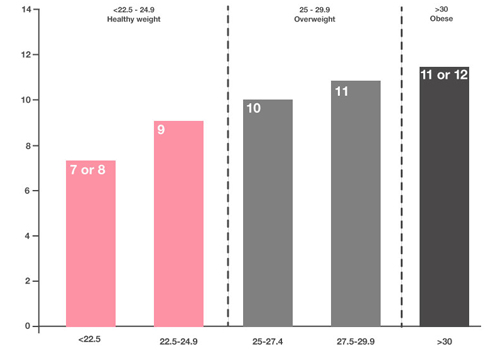
You might not be able to change some breast cancer risk factors like your family history or aging, but there are some things that you can control. Having a family history of breast cancer can increase your risk, however it isn't just those with it in their genetics, in fact about 8 out of 10 women do not have it in the family.
Although there is no sure way to prevent breast cancer, there are some ways you can modify your lifestyle to help stack the odds in your favour. By living healthily, limiting how much you drink, keeping to a healthy weight and being physically active can help lower the chances of the disease developing.
1. Watch your weight
Put simply, being overweight or obese can increase your risk of breast cancer, especially after menopause and for women who gain weight as adults. Post menopause, most of a woman's oestrogen comes from fat tissue so by having more fat tissue you increase your chance of developing breast cancer. Being overweight also tends to increase your insulin levels, another hormone.
If you're already at a healthy weight try and maintain that and if you're carrying a few extra pounds, try to lose some. There's some evidence that losing weight may lower breast cancer risk, even losing as little as 200g a week. Plus, it can also have other health benefits. It's a good place to start!
If you struggle with weight loss or maintaining a healthy weight, why not try meeting with a nutritionist to design a meal plan adapted to your goals. In fact, regular exercise and a healthy balanced diet are recommended for all women as they can help prevent many conditions, including heart disease, diabetes and many forms of cancer.
The most common way of checking if you are a healthy weight is by working out your BMI (Body Mass Index). To do that you need to divide your weight in kilograms (kg) by your height in metres (m), then divide the answer by your height again to get your BMI.
The higher your BMI after menopause, the higher your risk of breast cancer will be. This graph from breastcancernow.org shows the estimated number of women out of 100 who will probably develop breast cancer at age 50 or above.

So in a group of 100 women with a BMI between 22.5 and 24.9 (within the healthy range), about nine will probably develop breast cancer at age 50 or above. But in a group of 100 women with a BMI of 30 or more (in the obese range), about 11 or 12 will probably develop breast cancer.
Don't panic! Maintaining a healthy weight doesn't have to be difficult, you just have to find what works for you. A few things to keep in mind include
• Eating a balanced diet rich in fruit and vegetables.
For example, researchers at Harvard recently discovered that women with high carotenoid levels in their blood had a 19 percent lower risk of breast cancer than those with the lowest levels.
Carotenoids which are vibrant pigments that act as antioxidants are found in fruit and vegetables such as leafy greens, carrots, sweet potatoes, tomatoes and red peppers.
• Eating less sugary or fatty processed foods.
• Eating and drinking the right amount for you and consuming the right amount of calories per day.
If your weight is something that concerns you, it is always a good idea to speak to your doctor or a clinical nutritionist before making drastic lifestyle changes.
2. Exercise regularly
Exercise can help you reduce the risk of breast cancer in several ways. Probably most obviously exercise helps you to control your weight. It is suggested that women who have gained 21 to 30 pounds since age 18 are 40% more likely to develop breast cancer than those who hadn't gained more than 2Kgs.
You can blame it on oestrogen; this hormone can stimulate cell overgrowth which can, in turn, cause breast cancer. Before menopause, most of your oestrogen is produced by your ovaries but after menopause, they stop pumping out the hormone and most of it becomes fat tissue. The more fat in a woman's body, the more oestrogen.
There have been numerous studies which have found that exercise and breast-health go hand in hand. Getting at least 150 minutes of moderate-intensity activity or 75 minutes of vigorous activity each week (or a combination of both) can help reduce your risks – which is not to say you have to squeeze that into a single workout! You can spread it out over the week.
What counts as a physical activity?Any activity that makes you breathe harder and get warmer counts towards your minutes. The more active you are, the more you can reduce your risk and it doesn't have to be at the gym.
You might prefer swimming, cycling or playing sports to pounding a treadmill or lifting weights. Just keep in mind that your everyday activities like brisk walking or walking up stairs also count. In fact, mowing the lawn, washing the car, gardening, vacuuming and pushing a pram or wheelchair also count towards your daily activity levels so don't discount a good spring clean!
Getting up and getting moving isn't just good for your breast-health, it can also improve your mood, help you relax, improve your sleep and generally improve your mental as well as your physical wellbeing. Obviously, you don't have to start training for a marathon but in order to reduce the risk of breast cancer—and all cancers— make sure you're moving!
3. Limit your alcohol intake
The risk of you developing breast cancer can be effected by how much alcohol you tend to drink. The more alcohol you drink, the more likely you are to develop breast cancer at some point in your life.
Research has shown that women whohave 2 to 3 alcohol drinks a day are 20% more at risk compared to women who don't drink at all. Women who have 1 drink a day have a very small increase in risk. Excessive drinking increases the risk of other cancer types, too such as liver disease, heart problems, and numerous other conditions.
With so many different drinks, cocktails, glass sizes and serving sizes it can sometimes be difficult to figure out how much alcohol is actually in your drink so units are used as a simple way to express how much pure alcohol is in a drink.
In total, you should not be consuming more than 14 units per week; a single measure of spirits (25ml) is equal to 1 unit, a standard glass of wine (174ml) is 2.1 units, a pint of large, beer or cider can range from 2 – 3 units depending on the percentage of the beverage.
4. Avoid or limit hormone replacement therapy.
Research suggests that long-term use of combined oestrogen plus progestin therapy, which is used to manage menopausal symptoms amongst other things, increases a woman's risk of breast cancer by 24%. However the risk of breast cancer appears to return to normal within 5 years of stopping the combination of hormones.
But unless your risk is significant (if you have a family history of breast cancer for example), you can speak to your doctor about using hormone therapy to manage the unpleasant symptoms of menopause, such as hot flashes.
If you're wondering: hormone replacement therapy can help relieve symptoms by increasing oestrogen levels which research indicates can cause some breast cancers to grow.
Your doctor may also prescribe hormone replacement therapy to reduce a woman's risk of developing osteoporosis (weak bones) in the short term and improve muscle strength but it can come with some side effects including headaches, feeling sick and breast tenderness. These usually happen in the first few months. Taking these hormones also may slightly increases the risk of having a blood clot or a stroke and may slightly increase the risk of ovarian cancer.
5. Research your family history & check often
Between 5 & 10% of all cancers, including breast cancer, are hereditary – and it's not just your mother's family but your father's too. While doing your research and asking questions, don't forget to take a look at second- and third-degree relatives(aka, your aunts, uncles, cousins, and more).
Take a look at your family's history of all cancers. , These can increase the risk of not only breast cancer but also ovarian cancer in women, pancreatic cancer in men and women, and early prostate and testicular cancers in men. Research shows that around 72 percent of women who inherit a BRCA1 mutation and 69 percent who get a BRCA 2 mutation will develop breast cancer by the time they hit 80.
If your family history worries you, enlist the help of a genetics expert who can help you identify genetic mutations early on. They will guide you on way to stay healthy, recommend more regular checks and be able to spot early warning signs.
You may have heard the word “previvor”? This is someone who hasn't had cancer but is at high risk – often someone who has a BRCA mutation but you don't need a faulty gene to be a previvor.
Even if you're of average risk – i.e. you have no family history – you should have a mammogram and clinical breast exam every one to two years starting in your early 40s. Women at higher risk should start screening earlier and more often.
On top of that, make sure you are giving yourself a breast self-exam regularly, s and that you are familiar with how your breasts feel normally so you can report any changes in appearance or texture to your doctor. Aways let your doctor know should you notice any bleeding or crusting on the nipples and if you experience any pain. It is one of the most effective ways to ensure early detection (you can learn how to do one here).
Over the last few years countless hours of research has taught us that there are numerous steps we can take to reduce the risk of developing breast cancer. Wherever you are in your life, there are steps you can take to live a balanced, vibrant, and health-filled life. Remember, by staying healthy throughout your life you can lower your risk of developing cancer.
Other Articles

- 3 Steps to Embrace the New You
- 18 Life-Changing Things to Do This Year
- Top Tips for Staying Healthy While Dining Out
- Why Consistency is more Important than Perfection
- 3 Ways to Put Movement Back into your Day
- How to make a New Year’s Resolution that sticks
- 8 Tips to Fall in Love with Healthy Eating (and stay there!)
- What to do this month - August
- What to do this month - July
- Staying Healthy at Work
- 5 Ways you can Reduce your Risk of Breast Cancer
- 5 Easy Steps to Weight Loss
- 4 Eating Habits For A Wrinkle-Free Skin
- 8 Weight Loss Mistakes
- 20 To Do’s To Avoid Catching A Flu
- 3 Reasons Why You Need to See a Nutritionist When You’re Pregnant
- Breast Cancer Awareness
- What does your hobby say about you?
- How Can You Improve Your Morning Mood?
- New Revelations Support Diet and Exercise to Reverse Leptin Resistance




